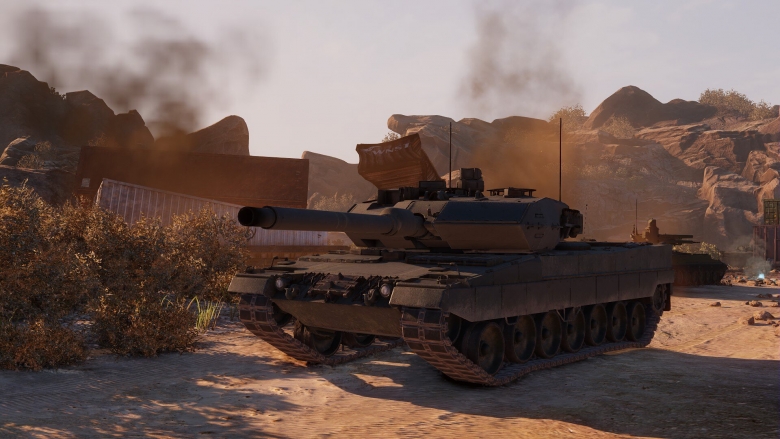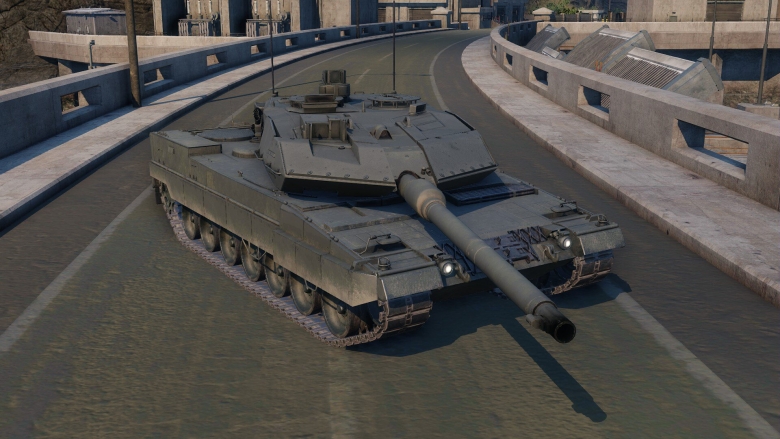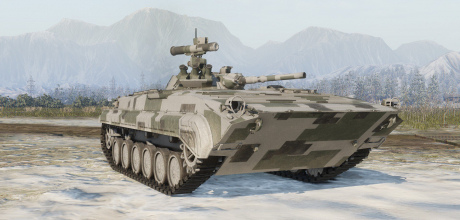
The Leopard 2A6 Main Battle Tank was, until the arrival of the modernized Leopard 2A7 in 2014, the most powerful member of the Leopard 2 family for almost 15 years.

While the vehicle does represent a significant step forward in terms of firepower, it is, for all intents and purposes, a Leopard 2A5 with a 120mm Rheinmetall L/55 smoothbore gun (replacing the older L/44) and a few additional changes to the Fire Control System.
By the time the Leopard 2A6 arrived in March 2001, installation of the longer Rheinmetall smoothbore variant had been considered for over a decade. The original Leopard 2 improvement program (KWS) included this feature in one of its stages (KWS I), but it was not quite as simple as just mounting a longer cannon.
Leopard 2 evolution schematics by Madestcat
The German military resisted the installation of (any) longer gun because of the environment the vehicle was expected to fight in. While the Leopard 2 was designed as a universal vehicle, it was clear from the start that any major action it would participate in would be in West Germany against an invading opponent. West Germany was not just a country with advanced infrastructure, but also with many urban and wooded areas that had to be defended. An excessively long gun can interfere in such environments – something German engineers were also aware of in World War Two, since one of the main reasons why the Panzer III 50mm L/42 was not upgraded to L/60 earlier was that, apart from being sufficient for its job, a longer gun would cause problems in cities.
Despite the budget cuts connected to the fall of the Soviet Union, the expected appearance of modernized Soviet (and later Russian) tanks did finally push the Germans to accept the plan to up-gun the existing Leopards 2s to the L/55. Two seventh production run Leopard 2A5s were tested with the 120mm L/55 in 1997, as a part of the KWS I program.

Leopard 2A6
Following the successful tests of the up-gunned Leopard 2A5s, an upgrade of 225 Leopard 2A5s with the L/55 gun was approved in 2000. Apart from the gun, the upgrade also included:
- Redesigned thermal shroud
- Modified muzzle reference system
- Modified stowage box for empty cases
- Modified gun recoil system
- Modifications to electronic systems such as the Fire Control System, EWNA electric gun control system and the integrated diagnostic system
- Minor adjustments to internal control panels
In addition to the abovementioned changes, the new gun was also capable of firing the new 21.4kg LKE II APFSDS rounds with tungsten penetrators (the German military does not use depleted uranium due to environmental and health concerns). The maximum range increased to 4000 meters. These modifications made the vehicle 400 kg heavier and 1.3 meter longer (with the gun facing forward). Thus upgraded, the Leopard 2 was re-designated to Leopard 2A6.

Leopard 2A6 turret spaced armor
The first Leopard 2A6 was delivered to the Bundeswehr on March 7 2001. Originally, all German Leopard 2A5s were to be upgraded to the Leopard 2A6 level, while leaving some of the original Leopard 2A4s in service along with the Leopard 2A6. However, the plan collided with the Leopard 2A4 to Leopard 2A5 upgrade program and it was subsequently decided to upgrade 65 Leopard 2A4s directly to Leopard 2A6 while leaving 125 Leopard 2A5s in service (not in active duty, but for training purposes). In total, the Bundeswehr therefore operated:
- 125 Leopard 2A5s
- 290 Leopard 2A6s (70 of which were later converted to 2A6M)
Leopard 2A6M
Unfortunately, the introduction of the Leopard 2A6 coincided with one of the biggest changes in the nature of armed conflicts – the War on Terror – and the shift from classic symmetric warfare, which the Leopard 2 was built for, to asymmetric warfare, where the biggest threat to a tank (especially in urban areas) comes from RPGs, IEDs and mines.
To respond to these new threats and using the experience gained in Afghanistan and Iraq, KMW introduced a modified Leopard 2A6 with improved protection against mines and IEDs. This variant, designated Leopard 2A6M, had an additional lower front and belly armor plate attached to protect the crew (Minenschutzplatte – hence the M in the designation). The biggest changes however happened inside the vehicle. The crew compartment was changed for maximum protection from blasts from below. These changes included removing the bottom row of the ammunition rack and new seats for the crew.

Leopard 2A6M in Canadian service with an additional anti-RPG net
The first of the 70 vehicles produced (upgraded from the Leopard 2A6s) was delivered to Bundeswehr in July 2004 with production running until 2008. Twenty Leopard 2A6Ms were subsequently lent to Canada for its mission in Afghanistan. There they served with distinction with at least one case recorded in which the heavy additional plating saved the crew (with the exception of the driver) from injuries from an IED blast.
Leopard 2A6 Demonstrators
The history of the export variants of the Leopard 2A6 runs partially in parallel to Leopard 2A6 development. Between 1998 and 1999, KMW built a demonstrator vehicle based on the Leopard 2A4 (the internal KMW designation was DEMO I). This vehicle was not intended as a viable combat unit. The task instead was to cram it with as many technological improvements as possible to attract foreign buyers by showing that even a simple Leopard 2A4 could be upgraded to Leopard 2A6 level. The main improvements compared to the Leopard 2A4 included:
- Rheinmetall 120mm L/55 gun
- Improved armor (Strv 122 level with improved roof and hull armor)
- Auxiliary power unit
- Air conditioning
- Improved FCS
And several smaller upgrades. This vehicle was named Leopard 2A6EX and was shown to the public at numerous expos and during various events from approximately 2001 to 2005. It was this variant that caught the attention of Turkey (unsuccessfully), Spain and Greece and in a way became the ancestor of the Leopard 2E and Leopard 2A6HEL.

Leopard 2A6EX
There was also a second Leopard 2A6EX (its internal designation was DEMO II). It featured a new compact MTU and Renk power pack (known as the Euro Power Pack), allowing the heavier and heavier Leopard 2 variants to keep their mobility. The power pack consisted of a 1500hp MTU MT 883 12-cylinder engine and a Renk HSWL 295 TM transmission. Secondary goals included an improved air intake and the reduction of emissions, making the vehicle harder to detect.
While the engine's power output remained the same as that of the original power pack, the Euro Power Pack was considerably smaller, lighter and consumed less fuel. However, installing it required considerable modifications to the vehicle's engine compartment.
Replacement
The Leopard 2A6, along with the Leopard 2A7 (introduced in 2014), is currently the standard Main Battle Tank of the Bundeswehr and it remains one of the most popular western MBTs. There are a number of foreign variants as well, most of which are slightly modified compared to the standard Leopard 2A6:
- Canadian Leopard 2A6M CAN (based on positive experience with the German Leopard 2A6M in Afghanistan)
- Greek newly-built Leopard 2A6HEL
- Spanish Leopard 2E
The Netherlands also operated a number of Leopard 2A6NLs until 2011. These were sold to Finland after unsuccessful attempts to sell them to Peru and Indonesia.
In Armored Warfare
The Tier 9 Leopard 2A6 is a mixture of the classic Leopard 2A6 and the Leopard 2A6EX. Unlike the previous tiers, the Leopard 2A6 has an armor upgrade option for additional hull and roof armor plating, which is present in real life on the Swedish Strv 122. This EX Armor Package improves frontal hull thickness by around 30 percent. Frontal-side protection is considerably improved as well, making this vehicle quite tough unless the frontal armor is targeted from an elevated position.

On the downside, the rear is extremely thin, making even the upgraded armor variant very easy to penetrate from behind by pretty much anything the tank encounters. This means it is vital to protect your rear armor and partially sides. Unlike the M1A2 Abrams and the T-90MS, the Leopard 2A6 is not protected by an ERA kit.
The 120mm L/55 smoothbore gun can fire all types of standard ammunition (including LAHAT guided missiles). The tandem LAHAT guided missiles especially do have a very high penetration value, but can be taken out by advanced ERA or APS systems, which are widely used on high tiers. The gun handling, on the other hand, is average.

Mobility-wise the Leopard 2A6 is quite good, despite not having an upgraded engine available. The technology available includes smoke grenade launchers, accuracy on the move, view range improvements and an APS. One of the tank's major drawbacks is the retrofit setup (one Universal slot, one Firepower slot and one Mobility slot), while other Tier 9 MBT have more suitable retrofit slot types available.
Nevertheless, the Leopard 2A6 is a powerful, universal vehicle and – much like its lower Tier predecessors – can be completely deadly in the right hands.









